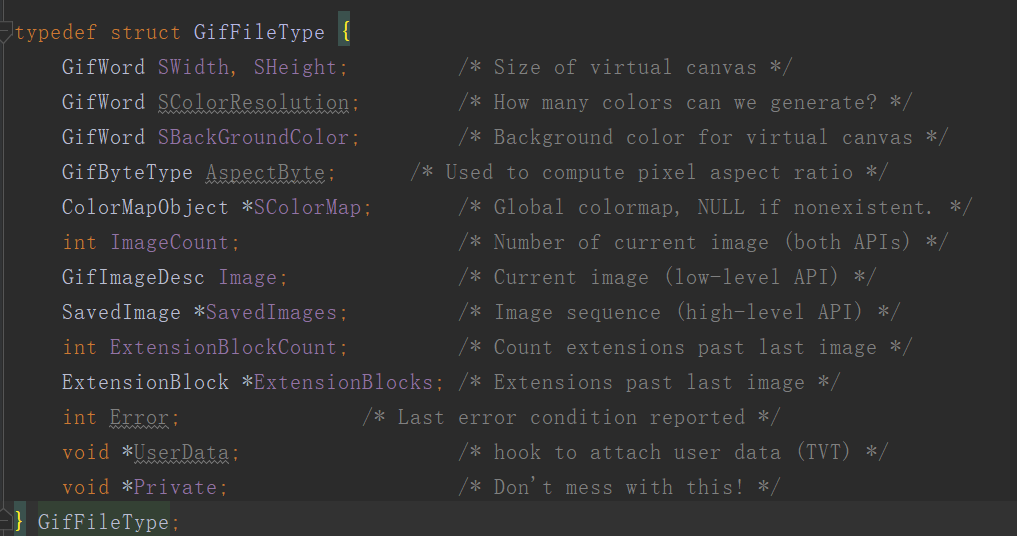android使用giflib加载gif
属于个人所创,转载请标明文章出处:
https:////www.cnblogs.com/tangZH/p/12356915.html
背景不多说,反正ndk加载gif比java上加载gif好很多很多,主要体现在内存占用与cpu消耗上。使用ndk加载占用内存更小,消耗的cpu更少。
要使用ndk加载,需要用到giflib库,Android源代码里面其实也用到了这个库。
一、下载giflib
https://sourceforge.net/projects/giflib/
二、构建so库
1、把需要用到的代码拷贝进来

2、实现我们的CMakeLists.txt
cmake_minimum_required(VERSION 3.4.1) set(SOURCES) file(GLOB_RECURSE SOURCES ${CMAKE_SOURCE_DIR}/*.cpp ${CMAKE_SOURCE_DIR}/*.c) add_library( native-lib SHARED ${SOURCES}) set(LIBS) list(APPEND LIBS log jnigraphics) target_link_libraries( native-lib ${LIBS})
语法上就不多说了。
注意还需要用到log库和 jnigraphics库,一个是用来打印log,一个是用来图片解析的时候用到。
3、新建java类GifHandler,在里面新建本地方法,方便等会直接用快捷方式在native-lib里面生成
package com.example.gifndk; import android.graphics.Bitmap; public class GifHandler { static { System.loadLibrary("native-lib"); } private volatile long gifInfo; public GifHandler(String path) { gifInfo = openFile(path); } public synchronized int getWidth() { return getWidthN(gifInfo); } public synchronized int getHeight() { return getHeightN(gifInfo); } public synchronized int getLength() { return getLengthN(gifInfo); } /** * @param bitmap * @param index 第几帧 * @return */ public long renderFrame(Bitmap bitmap, int index) { return renderFrameN(gifInfo, bitmap, index); } private native int getWidthN(long gifInfo); private native int getHeightN(long gifInfo); private native int getLengthN(long gifInfo); private native long renderFrameN(long gifInfo, Bitmap bitmap, int index); private native long openFile(String path); }
通过这些方法获取宽度,高度,帧数,渲染,打开文件。
4、native-lib代码,这里编写我们的本地代码
首先需要引进的头文件有:
#include <jni.h> #include <string> #include "giflib/gif_lib.h" #include <android/bitmap.h> #include "gif.h" //双引号是从本地项目找,找不到再从系统找,<>是直接从系统找
<android/bitmap.h>NDK中带的头文件,解析图片要用到。
gif.h我们自己新建的头文件,等会讲
首先看openFile方法
extern "C" JNIEXPORT jlong JNICALL Java_com_example_gifndk_GifHandler_openFile( JNIEnv *env, jobject /* this */, jstring path) { const char *path1 = env->GetStringUTFChars(path, 0); int err; GifFileType *gif = DGifOpenFileName(path1, &err); err = DGifSlurp(gif); env->ReleaseStringUTFChars(path, path1); return reinterpret_cast<jlong>(gif); }
这个方法主要是获取到GifFileType的指针地址。
GifFileType里面有gif文件的各种信息。

从注释也可以看出具体的含义。
顺便说一下UserData,这个其实相当于tag,类似于可以给一个view tag标识。
获取到到GifFileType之后便可以通过它获取宽度,高度,帧数,方法如下:
extern "C" JNIEXPORT jint JNICALL Java_com_example_gifndk_GifHandler_getWidthN(JNIEnv *env, jobject thiz, jlong gif_info) { return ((GifFileType *) gif_info)->SWidth; } extern "C" JNIEXPORT jint JNICALL Java_com_example_gifndk_GifHandler_getHeightN(JNIEnv *env, jobject thiz, jlong gif_info) { return ((GifFileType *) gif_info)->SHeight; } extern "C" JNIEXPORT jint JNICALL Java_com_example_gifndk_GifHandler_getLengthN(JNIEnv *env, jobject thiz, jlong gif_info) { return ((GifFileType *) gif_info)->ImageCount; }
获取到相关信息后,我们就要进行渲染了。
先讲一下我们的原理,我们的原理是获取到信息。通过宽高构造一个bitmap,根据每一帧图片之间的间隔,拿这个bitmap去渲染,也就是通过这个延时时间循环去加载每一帧图片。
renderFrameN方法
extern "C" JNIEXPORT jlong JNICALL Java_com_example_gifndk_GifHandler_renderFrameN(JNIEnv *env, jobject thiz, jlong gif_info, jobject bitmap, jint index) { GifFileType *gifFileType = (GifFileType *) gif_info; //bitmap转成颜色矩阵 void *pixels; AndroidBitmapInfo info; int err; if ((err = AndroidBitmap_getInfo(env, bitmap, &info)) < 0) { return -1; } //也可以不判断,这里的格式需要有透明通道 if (info.format != ANDROID_BITMAP_FORMAT_RGBA_8888) { return -1; } //&pixels为指针的指针,即二维数组 if ((err = AndroidBitmap_lockPixels(env, bitmap, &pixels)) < 0) { return -1; } //渲染 long delay_time = drawFrame(gifFileType, &info, (int *) pixels, index); AndroidBitmap_unlockPixels(env, bitmap); return delay_time; }
AndroidBitmap_lockPixels(env, bitmap, &pixels)这个方法必须调用,它会锁定图片内存,同时呢,成功的话pixels会指向图片的地址。
相应的,下面就必须解除锁定:AndroidBitmap_unlockPixels(env, bitmap)
核心方法是这一句,当然这一句需要我们自定义头文件,也就是上面说到的gif.h
long delay_time = drawFrame(gifFileType, &info, (int *) pixels, index);
gif.h如下:
#include "giflib/gif_lib.h" #include <android/bitmap.h> #ifndef GIFNDK_GIF_H #define GIFNDK_GIF_H #endif //GIFNDK_GIF_H extern "C" int drawFrame(GifFileType *gif, AndroidBitmapInfo *info, int *pixels, int frame_no);
drawFrame方法如下,关于gif文件格式,可以自行百度,后面有空再写:
#define delay(ext) (10 *((ext) -> Bytes[2] << 8 | (ext) ->Bytes[1])) int drawFrame(GifFileType *gif, AndroidBitmapInfo *info, int *pixels, int frame_no) { GifColorType *color; //每一帧图片 SavedImage *frame; //扩展快,定义一些行为 ExtensionBlock *ext = 0; //描述文件 GifImageDesc *frameInfo; //颜色表 ColorMapObject *colorMap; int *line; int x, y, j, loc; int *px; //获取这一帧 frame = &(gif->SavedImages[frame_no]); //这一帧相关的描述文件,虽然描述文件已经在GifFileType里面声明了,但是没有赋值 //所以需要用这种方式 frameInfo = &(frame->ImageDesc); //这一帧的颜色列表 if (frameInfo->ColorMap) { colorMap = frameInfo->ColorMap; } else { //没有的话就获取全局的颜色列表 colorMap = gif->SColorMap; } //遍历这一帧的扩展块,找到具有GRAPHICS_EXT_FUNC_CODE标志位的,这个扩展快存放着对该帧图片的 //处置方法,是不处理还是其他 for (j = 0; j < frame->ExtensionBlockCount; ++j) { if (frame->ExtensionBlocks[j].Function == GRAPHICS_EXT_FUNC_CODE) { ext = &(frame->ExtensionBlocks[j]); break; } } //这时候px是二维指针 px = pixels; //frameInfo->Top:从哪个y坐标开始(距离顶部的top),乘以每一行的字节,就是我们需要开始遍历的字节 px = (int *) ((char *) px + info->stride * frameInfo->Top); //遍历y for (y = frameInfo->Top; y < frameInfo->Top + frameInfo->Height; ++y) { //行 line = px; //遍历x for (x = frameInfo->Left; x < frameInfo->Left + frameInfo->Width; ++x) { //当前的这一点 loc = (y - frameInfo->Top) * frameInfo->Width + (x - frameInfo->Left); //判断处置方法,拿到当前帧loc位置的字节,看是否等于扩展块中索引为3的字节,并且数值为1 if (frame->RasterBits[loc] == ext->Bytes[3] && ext->Bytes[0]) { continue; } color = &colorMap->Colors[frame->RasterBits[loc]]; line[x] = ((255 & 0xff)<< 24) | ((color->Blue & 0xff)<< 16) | ((color->Green)<< 8) | (color->Red); } px = (int *) ((char *) px + info->stride); } return delay(ext); }
那么接下来就是主工程的调用了。
private void load() { gifHandler = new GifHandler(path); int width = gifHandler.getWidth(); int height = gifHandler.getHeight(); bitmap = Bitmap.createBitmap(width, height, Bitmap.Config.ARGB_8888); maxLength = gifHandler.getLength(); long delayTime = gifHandler.renderFrame(bitmap, currentLength); imageView.setImageBitmap(bitmap); if (handler != null) { handler.sendEmptyMessageDelayed(1, delayTime); } /*Glide.with(this).asGif().load(path).into(imageView);*/ } Handler handler = new Handler(new Handler.Callback() { @Override public boolean handleMessage(@NonNull Message msg) { currentLength++; if (currentLength >= maxLength) { currentLength = 0; } long delayTime = gifHandler.renderFrame(bitmap, currentLength); imageView.setImageBitmap(bitmap); handler.sendEmptyMessageDelayed(0, delayTime); return false; } });
到此结束。
精美版本:http://77blogs.com/?p=305
源码地址:https://github.com/TZHANHONG/GifLibSample


